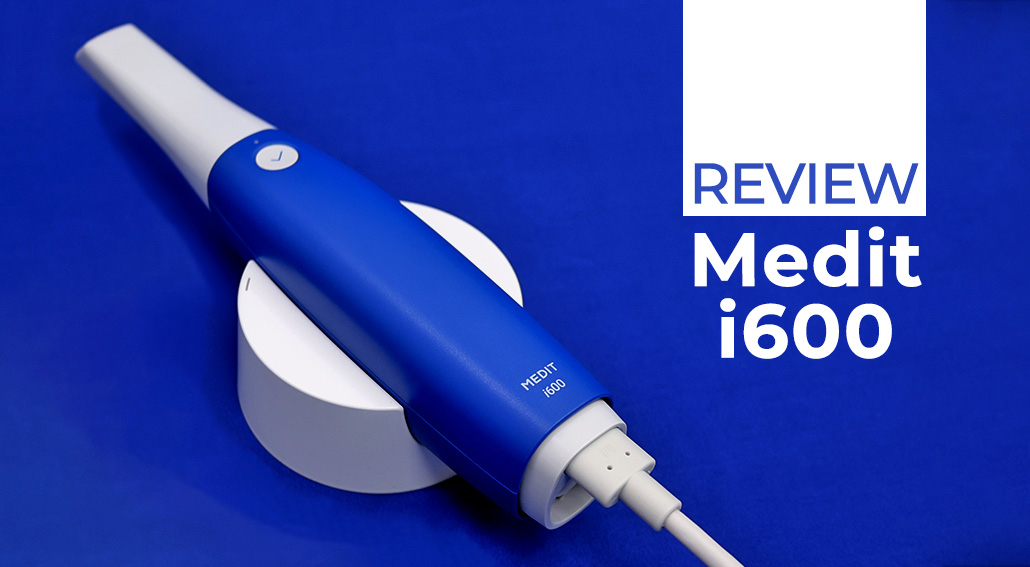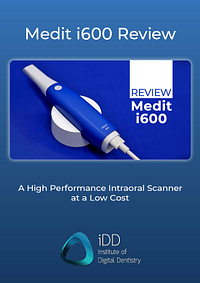The i600 is here. Medit's most affordable scanner.
On the 20th of April 2022, Medit announced the newest member of their intraoral scanner portfolio - the i700 wireless. This new scanner release was anticipated as there were whispers of a new wireless scanner coming before the launch.
What was a better-kept secret and surprised the entire industry was the concurrent release of the Medit i600.
In an effort to not price themselves out of the market, the strikingly blue Medit i600 is the most aggressively priced Medit IOS yet.
We have written many articles comparing the entire Medit lineup of intraoral scanners (read them here). Still, in this review, I wanted to summarize my experience using the i600 over the past three months and how it compares to the more expensive i700.
The following review goes over everything you need to know about the i600, and in summary, this is one of the best scanners at a low cost.
Background - the Medit i700
For those who don't know, Medit is a Korean digital imaging company founded in 2000 as a 3D scanner company for the industrial sector. They have since released several dental products, such as the Medit T-series lab scanners. Their intraoral scanner line-up consists of the i500, i600, i700, and i700 wireless.
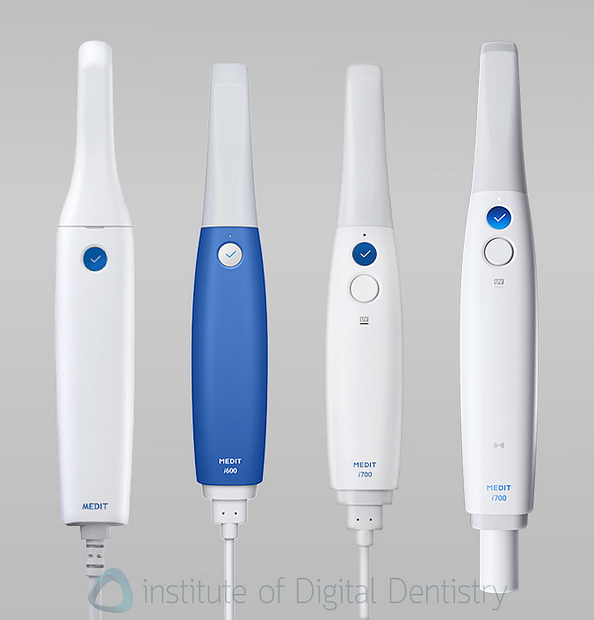
All the Medit intraoral scanners available today. Left to right: i500, i600, i700 and i700 wireless.
The Medit i600 is one of the newest intraoral scanners released on the market and the fourth Medit scanner following the incredible success of the i500 and i700.
The i600 is the successor to the i500. It is better in every way. The only reason to buy the i500 now is if the i600 is not yet available in your country.
The company previously branded itself as the 'easy entry into digital dentistry'. Although this terminology has changed to 'reimaging scanning', Medit is well aware of the falling scanner prices. The price wars have started for sure.
At the time, the i500 was one of the most affordable scanners on the market. As the market has heated up over time, the i700 and i700 Wireless are now mid-tier in terms of price.
The Medit i600 is the company's push to keep competitive in terms of cost. For those who don't know, the i600 shares many similarities to the i700. In fact, there are more similarities than differences. The Medit i600 shares the same scanner body, optical engine, scanning tips, and cable as the i700.
We have already extensively reviewed the Medit i700 here. So, for the most part, that review also applies to the i600.
What I will cover in this review is what are the differences between the i600 and how this impacted me in a real clinical setting, working on patients. Enjoy the review
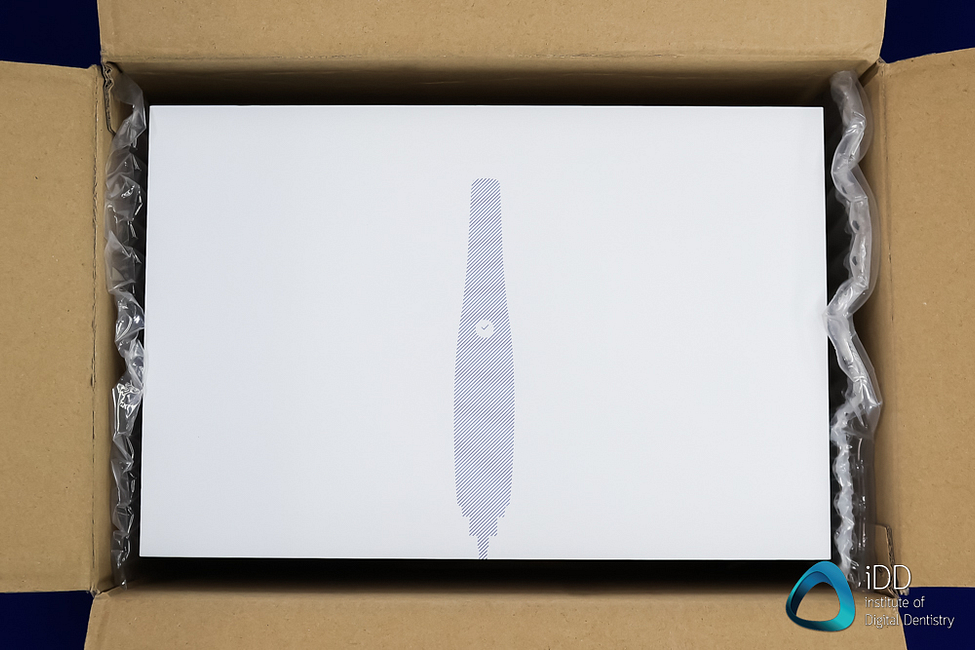
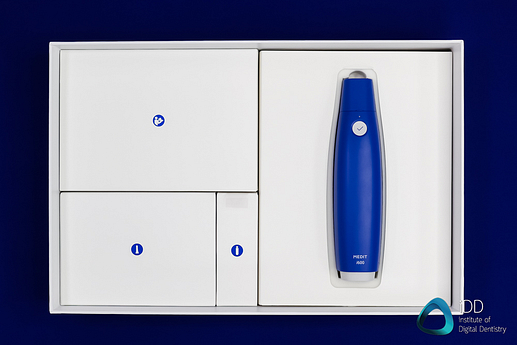
Unboxing the Medit i600.
Disclaimer - no conflict of interest. This is an objective review of the Medit i600. The team at iDD remains unwaveringly committed to providing you with impartial and trustworthy information. Medit had no part in writing this review or restricting any conclusions iDD makes in our thorough analysis and clinical use of these products.
Review Overview
Evaluation Ratings
Scanning Speed
Scanning Flow
Scanner Size
Ease of Use
Scanner Software
Investment Cost
Additional Features
Touch Screen
USB C scanner. Can be used with touch screen displays.
Wireless Scanner
Caries Detection
Software Apps
Huge line-up of scanner apps.
CAD/CAM Software
Relies on 3rd Party Software for permanent restorations.
Subscription Requirements
None. Cloud Storage has a monthly fee after a 1 GB limit.
Autoclavable Tips
100 or 150 times per tip
Scanning Speed
The i600 is an impressive intraoral scanner, especially for its price. It is fast and easy to use. This scanner easily competes with the more expensive scanners on the market, such as TRIOS, CEREC, and iTero. Using the Medit i600, I can achieve full-arch scans routinely in around 35-40 seconds.
The scanning protocol used with the i600 is similar across all scanners on the market, so for me, using it was simple. At first, the scanning image can look grainy, as is standard with Medit scanners, but after post-processing, the final scan images look great. The i600 produces high-definition color scans that look detailed.
The AI built into the Medit software is impressive. The scanner is quick to find its place again when the scan is paused and restarted. The software efficiently and accurately removes artifacts such as the tongue, cheeks, or gloves that might be picked up. Bite scan alignment is fast but is sometimes inaccurate. It pays to check this and rescan bites if they look off.
What makes Medit stand out in this market is the software. Many control options are built into it, such as AI sensitivity controls and even what colors the scanner should ignore. This software even has a tooth shade detection tool. These tools built into Medit software help improve scanning speed and functionality, and we wonder why these are not present in other scanners that cost twice or three times the price.
As mentioned above, the i600 performs very similarly to the i700. Please read our full review of the i700 to learn more or check out the video above to see a scan comparison.
All the benefits of Medit i700 at a low cost
The i600 is basically a low-cost i700. It comes in the same box and with all the same contents. It uses the same software and thus has the same software benefits. As mentioned above, there are more similarities than differences between these two models.
The size and ergonomics of the i600 are exactly the same as the i700. Scanner dimensions are 248 x 44 x 47.4 mm, and the total weight is 245 g. This scanner feels ergonomic when holding it, and it's easy to reach all the buttons.
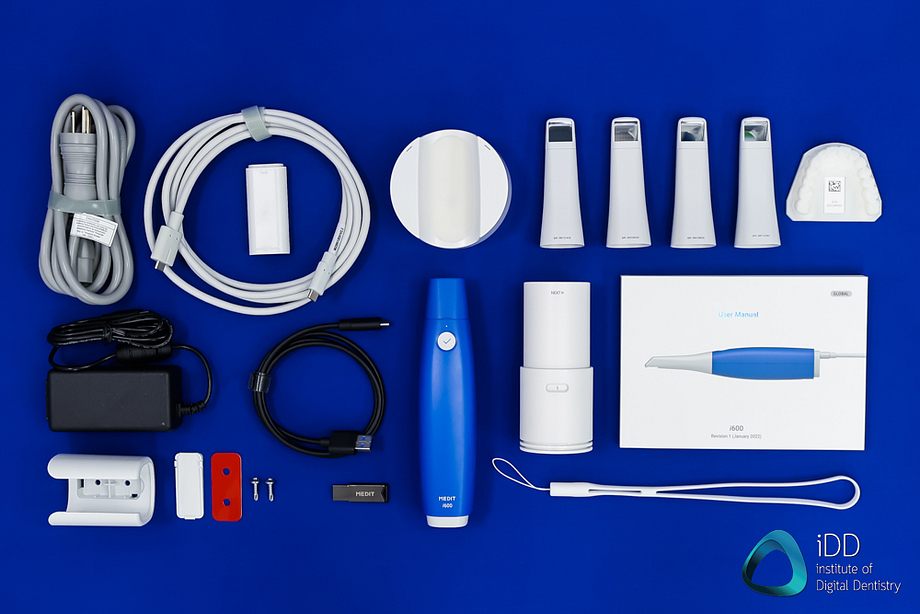
Everything that comes with the Medit i600. Almost exactly the same contents as the i700.
The i600 uses the exact same scanner heads as the i700. The scanner heads are fully reversible, which means they can be rotated 180 degrees and attached to the scanner. The scanner tips that come with the i600 are the older generation i700 scanning heads that can only be autoclaved up to 100 times (compared to 150 times with the new ones). Medit has also released a small scanner head option that came out earlier this year for smaller mouths.
The i600 is a wired scanner like the i700. The Medit i600 is plug-and-play, so you connect it to a suitable laptop/computer by USB and use it. If you use the USB-C connection directly to the laptop, you do not need a power box or connection to a power socket. It is one single cable to the laptop.
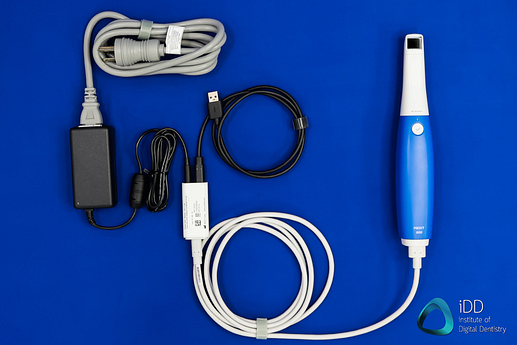
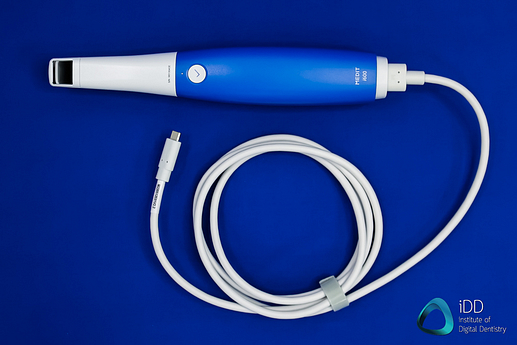
The i600 is a wired scanner with two options - a power socket connection or with USB-C connection alone
The i600 has an inbuilt fan in the scanner. Like almost every scanner on the market now, this makes scanning for long periods in the mouth easy as the fan prevents fogging of the scanner tip. The scanner does take a considerable amount of time to warm up when first turned on. We found it takes about 1.5-2 minutes and the software advises you to let the scanner warm up before use. The good news is you can bypass this and continue to scan if you are in a rush.
The i600 is an impressive scanner that handles full arch scans very well, especially for the cost. This scanner can take anything you throw at it - quadrant scans, full-arch scans, edentulous scans, implant scans, etc. I could easily carry out full arch scans in under 40 seconds. The i600 also performs very well when scanning edentulous sites as well.
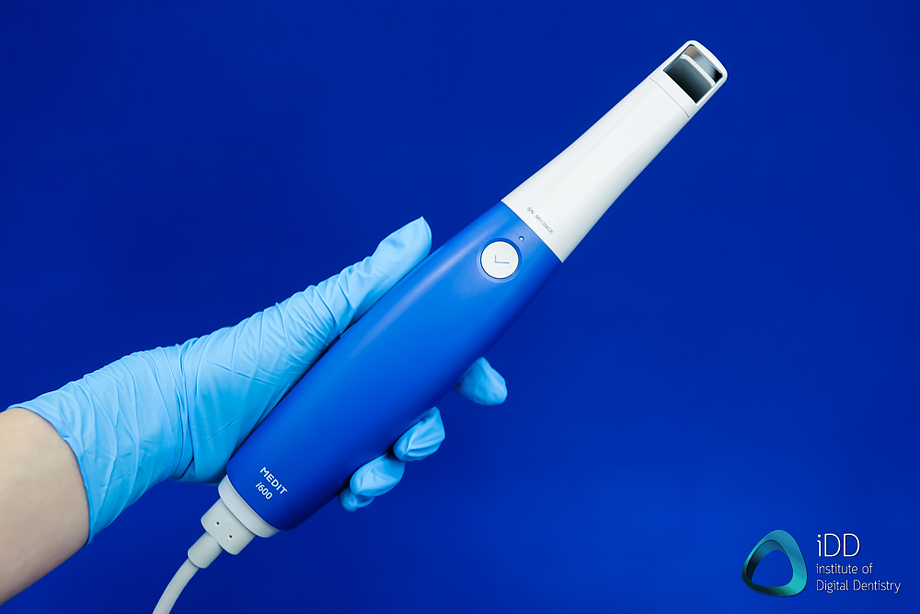
Medit i600 with scanning tip attached in reverse.
So the i600 performs basically the same as the i700. What are the differences then? Why does it cost $4500 USD less?
Well, there are four main differences. I will outline below how they impacted me in my office day-to-day.
No UV-C LED
The first difference in the i600 is that it does not have the UV-C LED technology seen in the i700. For those that don't know, Medit added a UV-C LED to the internals of the i700. This UV-C LED was supposed to aid in the disinfection of the inside of the scanner. The idea is that fans in intraoral scanners can push contaminated air through the internal part of the scanner, which remains unsterilized (unlike scanner heads which can be autoclaved).
Apart from the announcement of this new tech at release, almost no one talks about this feature, and it is hard to conclude whether this UV-C LED is even required or is effective at disinfection. The other thing to note is that the UV-C LED only works when the i700 is connected to a power socket using the power hub. So not just a direct USB-C connection which most users prefer.
So, in summary, the fact that the Medit i600 does not have a UV-C LED had no impact on me in my day-to-day use of the scanner and because I only use the USB-C connection, for me, it is not even functional in the i700.
No Remote Control Button
The second difference between the i600 and i700 is that the i600 does not have a remote control button. This is a button found just beneath the scanner button on the i700.
A remote control button is becoming a more common feature seen in scanners. This extra button enables navigating the software and checking scan data without touching the keyboard. This includes switching between scan stages and rotating digital models. A remote control button is an excellent way to improve cross-infection control, arguably even more critical with laptop-based scanners.

i600 next to the i700. Note the lack of a remote control button and UV indicator on the i600.
Although it sounds good on paper, it is a function that takes time to get used to, doesn't quite work perfectly, and frankly, I found it slowed me down. I prefer simply training my dental assistant to progress the workflow on the laptop without compromising cross-infection. It is also a feature I would wager the majority of Medit users don't use regularly.
When I first got my i700 I found myself accidentally pressing the remote control button by mistake when trying to start a scan due to the close proximity of these two buttons. I seldom use the remote control button, so not having this feature in the i600 made little difference to me, if anything I preferred it not being there.
If this is a vital feature for you, be aware that it is not present in the i600.
FPS capped to 35
Although the i600 and i700 use the same optical engine, the i700 can scan up to 70-75 FPS while the i600 is capped to 35 FPS.
For those who don't know, FPS or frames per second is the frequency of images the scanner captures. In computing, for example, at 30 fps, 30 distinct images would appear in succession within one second. If the fps is too low, movement will appear jagged and jerky.
In my opinion, this FPS cap is the most significant difference between the i700 and i600. This means that even with a powerful PC/laptop, the i600 has half the FPS of the i700.
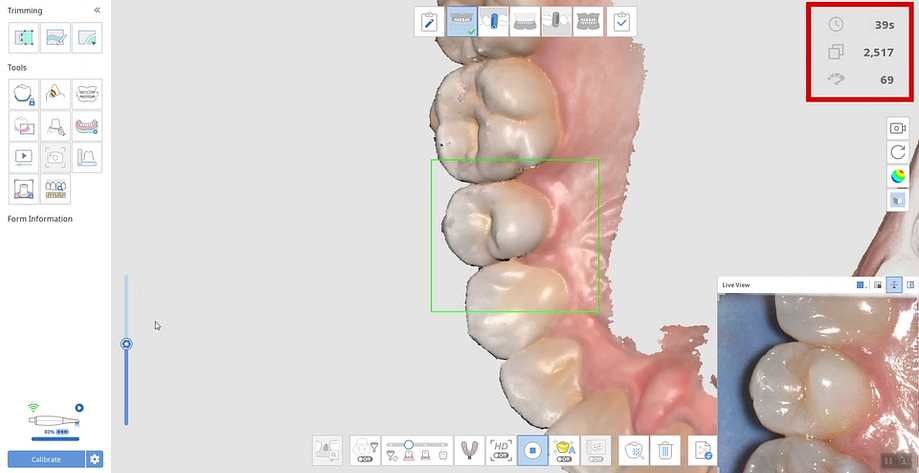
Scanning FPS is shown on the top right-hand corner in the Medit software. This image shows a scan taken with the i700 wirless at 69 FPS. i600 is capped to 35.
Now, the question is, does this matter, and if so, how much?
Well, in my experience, not much. I did not find the i600 to be significantly slower than the i700 in scan speeds or the accuracy to be worse. Check this video for a side-by-side comparison of scanning with the i600 and i700. The reality is the FPS cap is more of a quality of life inconvenience than anything. There is no doubt that scanning using the i700 appears slightly smoother, but this was never to the point where the i600 hindered me in a clinical setting, or I never felt it was unenjoyable to use.
If you want the best possible FPS from your Medit scanner, then get an i700. But if this single factor is not worth the extra $4500 USD to you, then I do not think you will notice a significant difference.
No HD Mode
The second most important difference between the i700 and i600 is that the i600 does not have an HD mode.
What is HD mode? It is a software toggle in the Medit software. This on-and-off switch makes the i700 scanner take a higher scan mesh density (see below).
Now I want to make something very clear. The i600 and i700 have the same optical engine. This is purely software. The topic of HD mode is very contentious. Some Medit users swear by it. The majority don't seem to use it or know it exists.
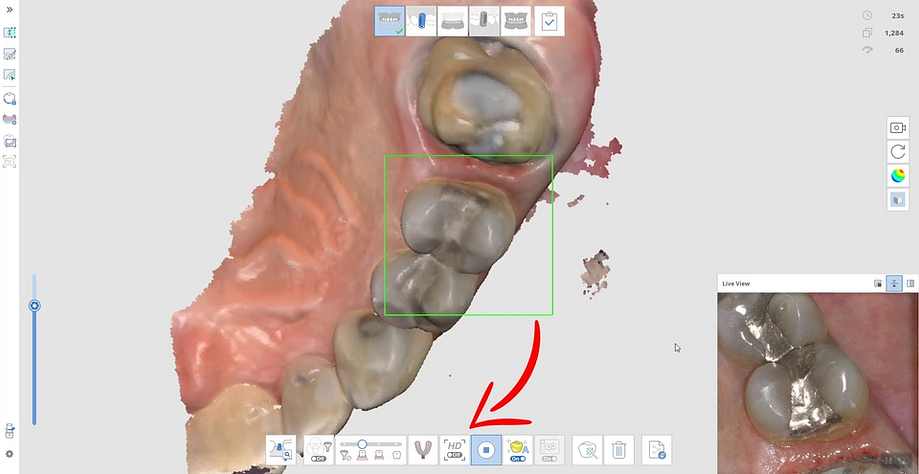
HD Mode is a toggle seen in the image above. This is only available for Medit i700 and i700 wireless.
The fact is, the HD mode can make scans look a little sharper. It can be helpful in veneer preps or areas of scans where you may get some overlap in tooth structures. But does it impact accuracy or speed? No. Is the i700 more accurate than i600 because it has an HD mode? No.
I personally hardly use the HD mode. Do I think it's hugely clinically relevant? No. Do I believe Medit would sell a scanner in large numbers without this mode if it is critical for use? Also, no.
It doesn't seem that the HD mode is vital for clinical applications, and for those on a budget, I would not worry about it not being an option for the i600. The company has advised me that they are developing the HD mode to be better in the future, but only time will tell what that actually means.
So that's the four main differences between the i700 and i600. That's it. Oh, and the i600 doesn't have vibration haptic feedback like the i700, which is triggered if you get lost during scanning. Another minor quality of life thing.
If the omission of these four differences (that you will likely not use much) doesn't bother you, save the $4500 USD. If you want the best possible Medit scanner with all the bells and whistles, I would go for i700 or i700 wireless.
Frankly, I was blown away by how good the i600 is as I expected a much inferior product compared to the i700, especially given by how much the company slashed prices.
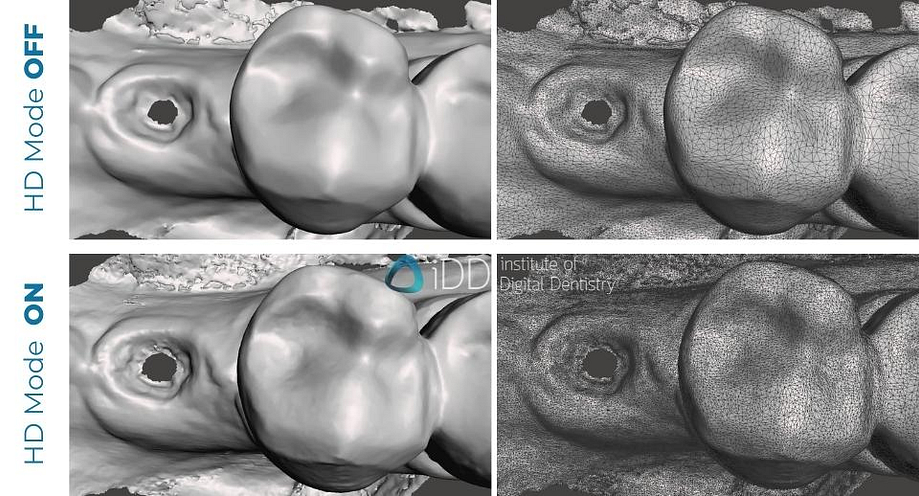
A comparison of i700 scan meshes with HD mode off and HD mode on.
Ease of Use
As with every Medit scanner, the i600 does well in making the scanning workflow straightforward for beginners and experienced users. Ease of use comes from the software that supports the hardware.
The Medit software, called Medit Link, is one of the most user-friendly and intuitive scanner software available. There are many on-screen tips, prompts, tutorials, and more. It is one of the most enjoyable software to use.
The same software is available for every Medit scanner. So you get all the same software benefits with the i600 as you would with the i700. Minus the HD mode.
The Medit workflow follows a simple step-by-step progression, almost identical across every IOS on the market. The typical workflow is as follows:
- Filling out the lab form and patient details
- Scanning the preparation
- Scanning the opposing teeth
- Scanning the bite
The part that makes the Medit scanners shine is the software's comprehensive features. It provides you with an impressive range of various tools during scanning and after - more on that in the section below.
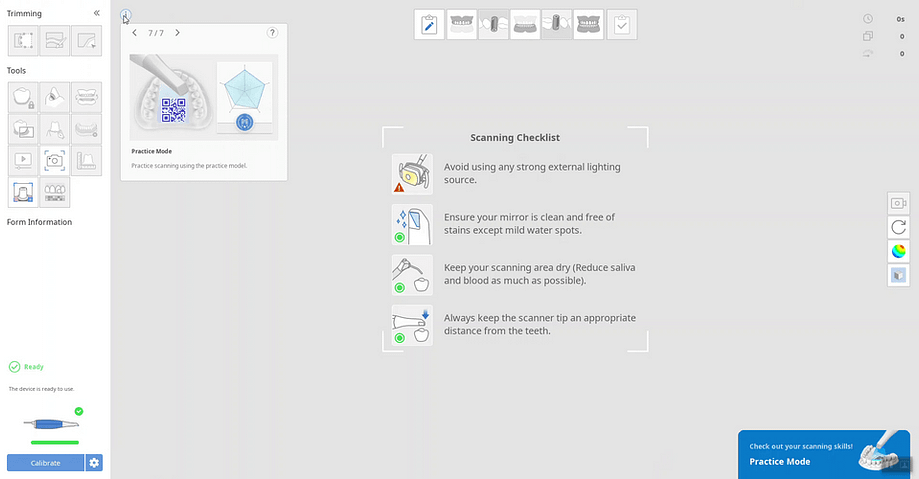
The Medit Link scanning software. Lots of tools and scanning tips + a practice mode.
Medit Link
The Medit Link software is the brains of the entire system. It is what runs the scanner and cloud storage.
Medit has dedicated a lot of time and resources into developing this software. When we reviewed the i700 last year, the software had far fewer features. It has been improved at a rate we have never seen in the entire scanner market.
Every single feature you can imagine is found in this software. Metal scanning, AI control, selective color scanning, tooth margination, AI implant abutment matching, smart scanning, and the list goes on and on. The software user interface is excellent and works well.
The Medit Link Dashboard looks aesthetic and lets you view your scans, lab order status, cloud usage, data storage space, and calibration intervals in one place. It also allows tracking various metrics, such as the number of scans per month, which is a nice touch. This software goes beyond just scanning patients and includes business management and performance tools.
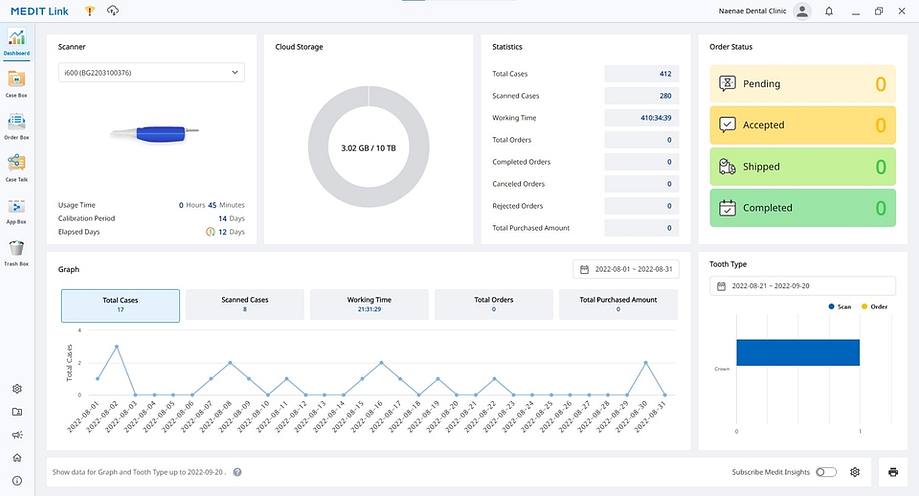
The Medit Link software looks great and works well.
Uploading to the cloud is something you will need to get used to, but it is easy and the software allows some offline work too. Note: you need a good internet connection to run any Medit scanner due to the cloud storage uploading. You will not be able to use this scanner permanently offline, so keep in this mind.
One thing the company has focused on with the Medit i600 is that it does not require a high-spec laptop to run it. In fact, the entire range of Medit scanners has been significantly optimized. Below are the specs needed to run the i600.
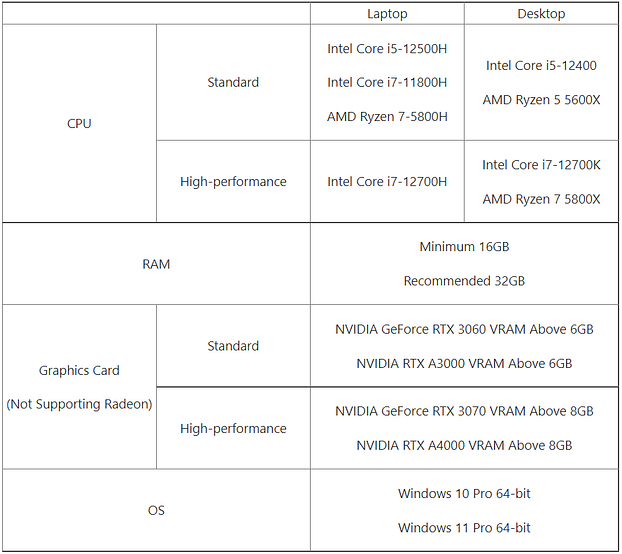
System requirements for the Medit i600.
Overall, the software is incredible and continues to impress with each new update the company releases. One of the most impressive features are Medit apps. There has been an enormous improvement to the apps over the years, and in this new Medit scanner review, it is the perfect time to update you on these.
Medit Apps
Medit has been working tirelessly to update their scanner software over the years. Back in November 2020, they released their first few Medit applications. Since then, we now have an entire suite of useful apps and what is basically meshmixer for Medit.
These Apps are classified by Medit into three categories - Medit Creator, Consultation, and Analysis.
The Medit Link apps include orthodontic simulation, smile design, medit design (mesh editor), model builder, crown fit checker, temporary crown and bridge app, and a splint app. There is also a DCM file converter (3shape files).
The Medit Apps used to be primarily communication tools, but now the suite includes a range of very effective CAD tools. You can create models, splints, temporary crowns, and bridges, all with with simple to use FREE apps.
In essence, the Medit software is getting closer and closer to becoming a fully fledged CAD software. I look forward to the day that happens.
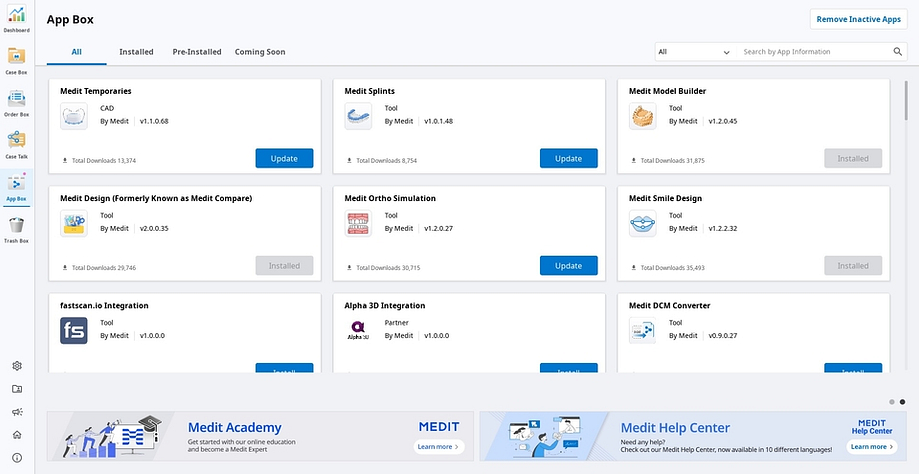
All Medit Applications can be found in the 'App Box' section of the software.
The applications found in Medit are not entirely new or groundbreaking, but the combination of all these applications, all in one package, is unique to Medit. For instance, most mainstream scanners now have some form of 'compare' function but not ortho simulation or smile design. iTero and TRIOS offer ortho simulation but not a splint builder etc. CEREC hardly comes with any meaningful software apps at all!
What is even more impressive about the Medit apps is not that they reinvent the wheel, but rather they make these apps very easy to use and the workflows more accessible than ever before. They also offer all these apps for FREE (can I say that enough?). These are not some cheap knock-offs. These are well thought out and very useful. You are also getting all of this with a much cheaper scanner than most on the market.
The other interesting thing about these apps is that they are not locked to only Medit users. Anyone can download the Medit Link software and use the apps with any scanner - even if they don't even have an i600 scanner.
In the following sections we will go over each one of these apps.
Medit Compare is now Medit Design
What used to be a simple app to compare two scans taken over time has evolved into one of the most powerful mesh (scan) editor software on the market. Medit Design, in the company's words, is a multifaceted app that can analyze, align, measure (including distance, area, length, and angles), and compare 3D data.
It provides you with various tools such as 'boolean,' 'offset,' 'smooth surface,' 'sculpting,' and many more. If you don't know what those words mean, you may need to scratch up your CAD designing CE/CPD.
You can check out our online Medit course here, in which we break down all the Medit apps.
With the Medit Design app, the company gives you the tools to design anything you want. It is basically like a sandbox, and many of Medit's users have come up with ingenious uses of this app. One interesting observation about this app is that it seems like the springboard for other apps. For example, initially, Medit splints were made in Medit Design via a long and tedious workflow, and now splints have their own easy-to-use app with a few clicks.
There is a disclaimer about Medit Design on Medit's that states: "the user assumes all responsibility and risk when working with Medit Design. Users should know that the results generated by the application may not be precise or reliable, and the results should only be used for communication purposes. Medit Design is not developed for use in medical or clinical purposes."
Hence, for most of us that don't enjoy tinkering with 3D data for fun, the Medit Design app will primarily be used to compare data from 2 or more scans. This tool allows you to see the differences in data sets. A software feature that is commonplace across many intraoral scanners and is often called patient monitoring.
You can overlay two or more different scan data sets and view surface roughness, curvature, and data deviation. Comparing scan data over time allows you to track changes in the dentition accurately. This application can be used for everything from tracking orthodontic movements over time to simple changes to a patient's dentition due to wear/bruxism.
Medit Design has both clinical and research applications. Notably, it can be an excellent patient education tool.
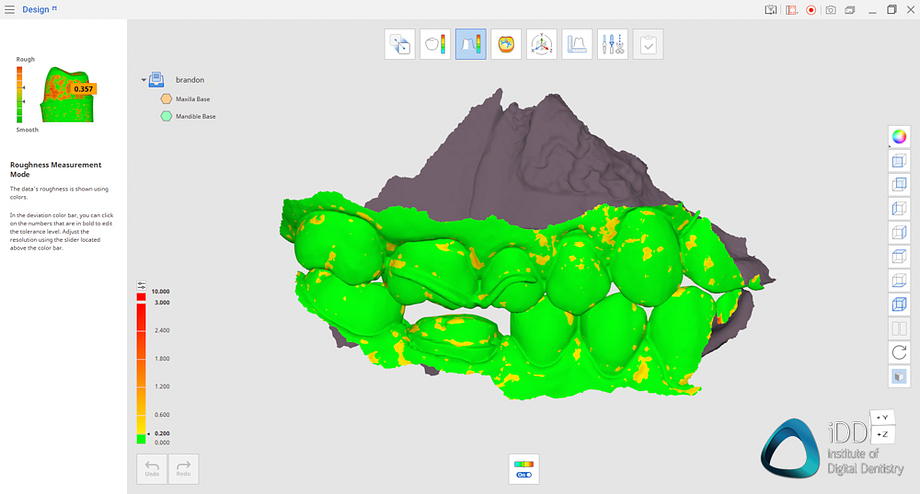
Medit Design has a range of features such as 'Roughness Measurement'.
Medit Orthodontic Simulation
Medit Orthodontic Simulation is a software app that allows you to create orthodontic simulations of teeth movement. It enables you to create several possible outcome scenarios by adjusting each tooth's position and can also be combined with face scan data.
It basically creates an orthodontic alignment animation after taking full arch scans. This is similar to what is seen in Carestream, TRIOS, and iTero with their ClinCheck simulator.
The Medit ortho simulator is good but not the best. It feels somewhere between iTero and Carestream orthodontic simulators. Carestream is very complicated and almost unsuitable chairside with a patient in the chair, and iTero is fully automated.
The Medit Orthodontic Simulator is not quite as complicated as Carestream but does require a few steps before getting an alignment ready to show the patient. These steps are all straightforward, and what Medit does well is its tutorials and helpful on-screen hints to move you along the process.
Medit Orthodontic Simulation includes automatic segmentation of all the teeth, which is done accurately most of the time. If any refinements are needed to the segmentation this can be easily. The simulations themselves can be a bit strange when done automatically by the AI, so the clinician does need to spend time learning how to use the app to make modifications to the final result.
The ortho simulations produced by the software are entirely interactive and can be modified as required. These simulations are a powerful motivation for any patient interested in orthodontics/aligners. An excellent free app for ortho-focused clinics.
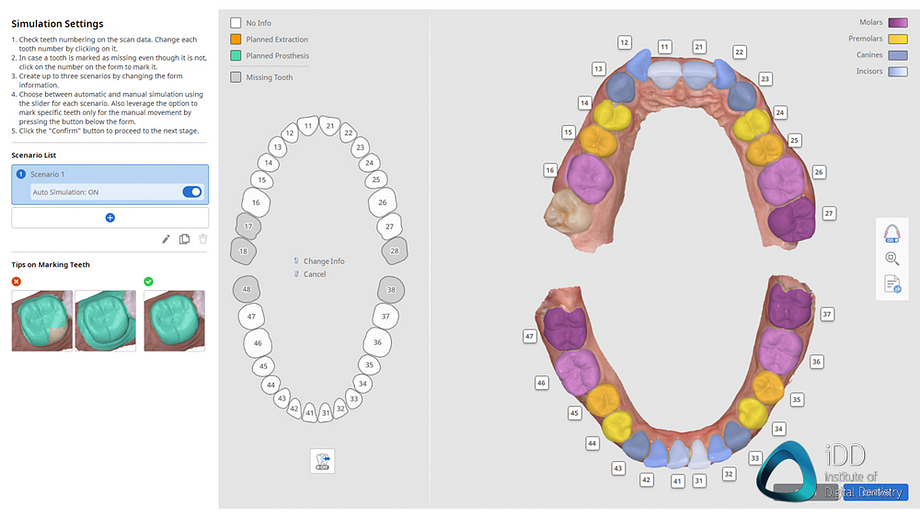
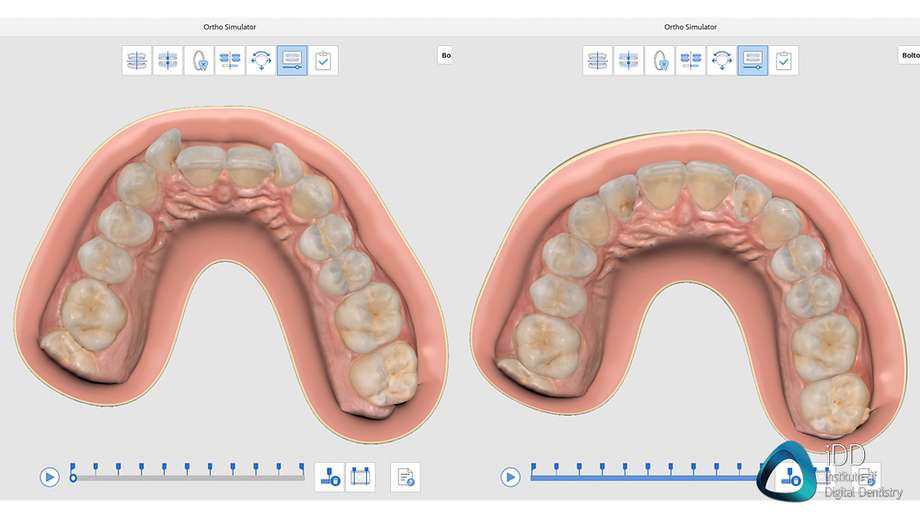
Medit Orthodontic Simulator in action.
Medit Smile Design
Smile design software has revolutionized cosmetic dentistry, and it is becoming more and more common to see this sort of application included in intraoral scanner software.
Smile design is a method of overlaying a smile simulation on a patient's picture. Medit Smile Design software allows you to perform a smile design by working on 2D images taken with an extraoral camera such as a DSLR that is then imported into the software.
With the Medit software, you can use the pre-set teeth templates and customize them with various tools to modify their color, shape, position, and scale. This app works well and is a fast and easy way to provide a patient with an example of what their smile could look like with cosmetic dental treatment. What Medit does well is making the process easy and accessible for users who may have never used a DSD program before.
What needs to improve is the tooth textures. They don't look quite as good as other programs, for example, 3shape smile design. They are simply not as aesthetic.
There are some unique features with Medit's take on smile design app, such as an orthodontic overlay, which can show the patient what their teeth may look like with metal/ceramic orthodontic brackets. Although a little funny looking, it is nice to see a company trying to innovate.
Overall, Medit Smile Design is a good DSD app that is easy to use. Their user interface does an excellent job guiding the clinician through the process - another great software addition.
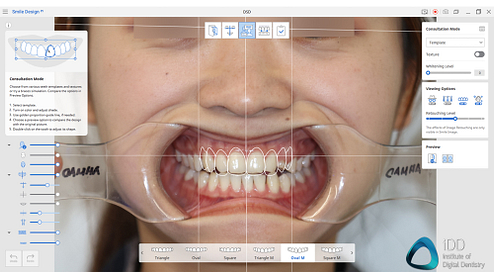
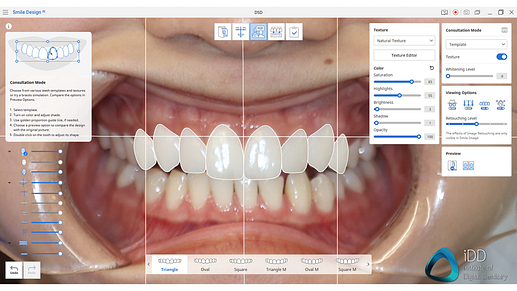
Medit Smile Design
Medit Model Builder
Medit's Model Builder allows you to quickly and easily design printable models within a few clicks. For those that don't know when you take a scan with any IOS device, these files cannot printed immediately. They need to be converted into a 3D printable file that includes adding a base to the scan itself. This is done by using model builders or Meshmixer software.
The Medit Model Builder is one of the best in the entire market, and a must-have, in my opinion, for anyone using 3D printers. Model builders are not unique software to Medit as this type of application is seen in many scanners such as iTero and Carestream. But just like all the other Medit applications, Medit somehow finds a way to make it easier and/or better.
This Medit Model Builder software is incredibly easy to use. Within 2-3 clicks, you can have a perfectly printable model with a range of customization options such as articulator pins or dies.
What Medit did exceptionally well here is making the process remarkably streamlined and giving you plenty of options for your models. You can choose any size of the model base, ABO bases, hollow or solid, drain holes or not, and add text or articulator pins. With the most recent software update there is now an option to create individual tooth dies, meaning that creating a Geller model is easier than ever before.
It is an impressive software app and one of my favorites in the entire Medit suite.
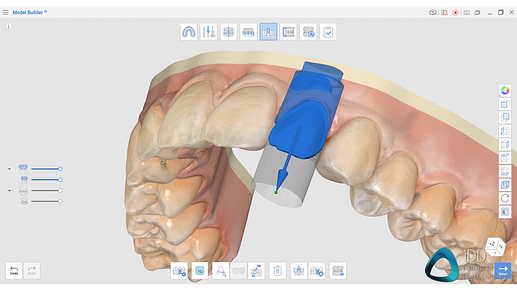
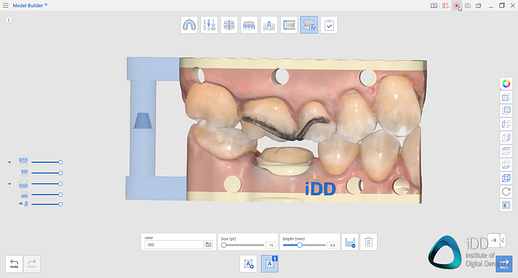
Medit Model Builder is one of the best software apps on the market.
Medit Crown Fit
Medit Crown Fit is a unique app made by Medit and it is an interesting idea. With the Crown Fit application, clinicians can conduct model-less crown fitting. This is done by combining CAD data of the crown design with the scan of the prepared tooth, and by taking scan of the milled or printed crown restoration.
After the prepped tooth and crown data are aligned, the software can reveal where any differences lie between the CAD-designed crown and restoration milled/printed, and if any alterations are needed in the prep for seating. Another feature of this app is the ability to compare milled/printed and CAD data to inspect your milling machine or 3D printer.
Although this is an entirely new application not seen in any other scanner or CAD software, I found it rare to actually need to use this app in a real-clinic setting. One reason for this is that I seldom have fitting issues with single-unit restorations. CAD software commonly blocks out any undercuts, so it is questionable how often this sort of app is actually needed outside of research. I don't really hear of many fitting issues from a single crown these days...
The other issue with this software is that it is not as user-friendly as the others in the Medit offering. The data required is not simple STL files of the crown design but rather construction files which won't be readily accessible unless you are doing the design in-house or ask your lab to send it - which is an unusual request. It is also limited to only 3Shape designs at this stage, so it cannot be used with exocad.
Medit Crown Fit is a unique idea but still requires a lot of work to make it more seamless. It is the one app I have not seen take off over the years, and I hardly hear of any Medit user actually applying it to their cases.
Medit Temporaries
Medit Temporaries is one of the newest Medit apps to be released and did not even exist when we reviewed the i700 one year ago. This app allows you to quickly and easily create temporary crowns and bridges. This software is one of the most exciting as it seems that Medit is bridging the gap between its app suite and an actual CAD software.
Like all other Medit apps, the app is very user-friendly and can be seamlessly integrated into your daily workflow, even if you have no CAD experience. This is much easier to use than any other CAD software such as exocad.
You can design temporary crowns that fit on your preps or egg-shell temps with a few clicks. You simply place a margin line on the area you want to temporize and follow a few easy steps and on-screen instructions.
One major limitation of this app when it was first released was that it required pre-op scans. In other words, there was no digital teeth design library. It also was limited to a single crown. These two significant limitations made the app seem practical in only a few clinical situations.
Recently, Medit updated the app significantly. It now enables multiple preps to be temporized, including bridges, and there is now a digital tooth library meaning no pre-op scan data is required.
This fantastic software app is getting close to being a fully-fledged crown and bridge CAD tool, and directly competing with exocad. If it can make temporary crowns, what stops it from being a permanent crown maker? Not a lot.
Medit Temporaries is one of the most impressive and exciting Medit apps. I will repeat it. You are getting this for free.
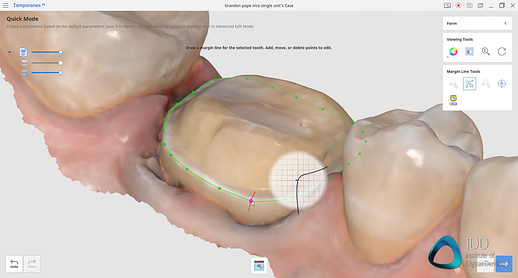
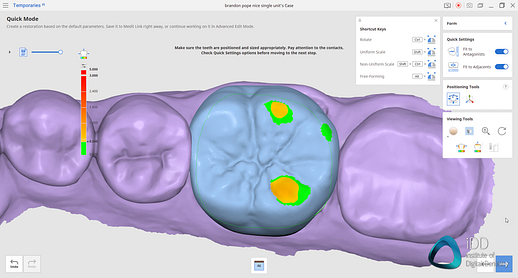
Medit Temporaries enables easy designing of crowns and bridges.
Medit Splints
The newest app to be added to the Medit collection is Medit Splints. Medit Splints provides a simple workflow for quickly creating splints, as you would have guessed. Prior to this app this process was done in Medit Design. It was a tedious workflow. The Medit team have made an app to make this a lot simpler and employ AI tech to automate a lot of the process.
The app includes an AI-powered Auto Creation feature, which creates splints in a few minutes. You just have to take a scan, select the arch you want the splint for, and start the splint design process via AI. Voilà you have a splint design.
There is also a manual creation mode that allows you to take control of the stages of splint creation step by step. For example, adjust the occlusal relationship to make room for the splint, outline the splint along the buccal and lingual sides and create the outer and inner surfaces.
The Medit Splints app can also analyze the characteristics of the anterior and posterior teeth automatically and uses this data to create the splint design. Each step in the program interface is accompanied by simple explanations and guide messages.
This is another very impressive app, although it leaves a bit to be desired. This free app is helpful, but the splint designs come out very flat on the occlusal surface. These are not the most sophisticated splint designs; frankly, I can imagine prosthodontists (or anyone with interests in occlusion) will squirm a bit when seeing some of these designs.
In saying that, just like the Medit Temporaries app that saw a considerable upgrade recently, I will not be surprised to see this app be further developed in the future. Medit Splints is a great tool to have.
So that summarizes everything with the Medit Apps. An incredible line-up of very useful tools and software.
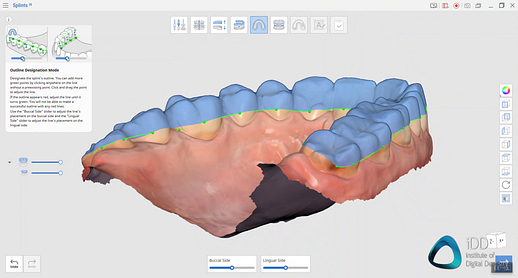

Medit Splints within 2-3 minutes.
Open or Closed Architecture
The Medit system is entirely open. The i600 enables easy exporting all scans in multiple formats, including STL, OBJ, and PLY. Note that many other scanners only allow STL export - notably CEREC.
You will often use STL as this is the most widely accepted scanning format across many labs and design software. One key distinction is that the STL file is NOT a color file. Although the scanner captures color, you will be designing a monochrome model when exporting in STL and opening in design software.
The other export formats (PLY and OBJ) provide full-color models; however, not all software or labs are open to using this. In saying that, it is becoming much more common to accept these formats.
The Medit Link software is also cloud-based software. All scans are automatically uploaded to the cloud if you have an internet connection. Using cloud-based software is becoming the norm in the scanner market and enables you to access your scans anywhere on any computer with an internet connection.
Apart form saving to the cloud, you can easily export any scans and download them locally.
Invisalign users, read this: For those of you who provide Invisalign treatment for their patients, Align Tech does NOT accept Medit scans for Invisalign treatment. This includes the i500, i600, i700 and i700 wireless.
Cost of the Medit i600
The cost of the Medit i600 is exceptionally aggressive in this competitive market. The i600 is one of the most affordable intraoral scanners. The RRP of the Medit i600 is $13,500 USD.
The company is also currently running a promotion in which they are selling the i600 at USD 9,990 until the end of September 2022. Crazy value for what you are getting.
Keep in mind that the cost of the Medit i600 does not include a laptop/computer to run it. You can expect to spend anywhere between $2000-$3000 on this. Also it does not include a cart, so factor that in too.
Lastly, an ongoing cost is the scanning heads. The i600 has removable and autoclavable scanning heads, which provide ideal cross-infection control. The cost of these scanning heads is $300 USD for a box of 4. Meaning $75 per scanning head that can be autoclaved up to 150 times. In other words $0.50 per patient.
Yearly Fees / Subscription
Like all other Medit scanners, the i600 has no subscription fees. The i600 and Medit Link software are entirely free to use.
Medit did however announce a subscription model around two years ago that is based on extra storage for their cloud service.
The Medit Link software has only 1 GB (used to be 10 GB) of free cloud storage for your scans. There is a cost for additional cloud storage if you require more space. Thankfully the price is not high (yet?) at $0.99 USD per month for up to 10 TB.
Although this is not mandatory, it will need to be considered if you are thinking of storing cases on the cloud long term, as 1 GB is not a lot. The size of an average single full arch scan is anywhere between 10-30 MB and that is in STL which is the smallest file. The raw data scans are much bigger. So in reality, the 0.99 USD per month for storage is something you will have to absorb.
Alternatively, you can remove any cases from the cloud and keep them stored locally if you wish to stay within the free limit, but this is a major nuisance and it not really worth the savings of one dollar. Note that the software is designed to upload all cases to the cloud automatically.
The Medit team has clearly stated that opting for the free membership will not affect scanning performance or the scanner's functionality. So the option is there regardless.
Review Summary
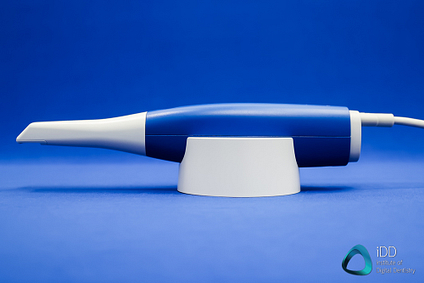
In summary, this is our in-depth review of the Medit i600 intraoral scanner. Much like the i700, the i600 is an excellent device. It shares so much in common with the i700 that it is hard to tell which is better in day-to-day clinical use.
The i600 is fast, easy to use, and the perfect entry point for those trying to get into the Medit ecosystem or digital dentistry in general. This product was planned and released very intentionally. Medit does not want to price itself out of the market as scanner prices are free-falling.
The company offers tremendous value at $13,500 RRP. With promotions running as low as $9,900 for this scanner, it is a no-brainer, for those considering their first IOS device.
Medit disrupted the entire industry with their intraoral scanners, and now it seems like they are doubling down. The i600 scanner impressed me in many ways, as when I heard the price, I expected it to be far inferior to the i700. That is simply not the case. The performance of the i600 is very close to the i700.
Most of the differences between the i600 and i700 are quality-of-life omissions and do not impact performance. The i600 has no remote control button, no UV-C LED, no wireless option, and no haptic feedback. The most crucial difference between the i600 and i700 is the lack of an HD mode and 35 FPS cap in the i600. These differences barely impacted me when using this scanner clinically.
This device is the successor to the i500 and now there is no reason to buy an i500 unless the i600 is not available in your country. This is the best low-cost option in the Medit range, and one of the best low-cost scanners in the entire market.
The scanner performance alone is impressive for its cost, and you also get all the software applications that come with the Medit software, which sweetens the deal even more. Medit have improved their software significantly over the past few years. Their apps are market leading. For example, Medit Temporaries, Model Builder and Medit Design are stand-out offerings. This collection of software applications all in one chairside software is rare to see in any IOS, especially for free.
There is a long list of merits of the Medit i600, especially compared to other products in this price range. This scanner is such a good value proposition that it is now hard to decide between i600 or spending $4,500 USD more for the i700.
Although Medit scanners offer excellent software, it is still not technically a CAD software for prosthetics. Suppose you are considering getting into in-house production. In that case, it can feel a bit piecemeal using Medit scanners as you will require a third-party design software (such as exocad) and a third-party milling machine.
This is not a deal breaker as we have tried and tested Medit scanners with various mills, but you will, without a doubt, run into more issues than you would with a complete system. For instance, getting an entire CEREC system is much easier, in which one system does everything and communicates seamlessly with itself.
If you want to see how we use Medit to provide our patients with single-visit ceramic restorations, check out our blog post here, were I have documented an entire case.
The intraoral scanner market has effectively split into niches. Those looking for a single system for chairside same-day restorations will likely get a CEREC. Those looking at the 3Shape workflow and want to use their excellent lineup of CAD software, for example, their fantastic implant planning and digital denture software, will go for TRIOS. Those who love Invisalign will go for iTero.
For the rest who just want a scanner to replace messy traditional impressions, the Medit i600 is a scanner that I can easily recommend for anyone looking at getting into digital dentistry on a budget.
It is incredible how the price point for intraoral scanners has dropped over the years. This is beneficial for all dental professionals worldwide as it will enable more adoption for those who are priced out. Medit has been instrumental in this price drop. They have shown the world you can provide a premium scanner without demanding a premium cost.
Thanks for reading. If you have any questions leave them below.

